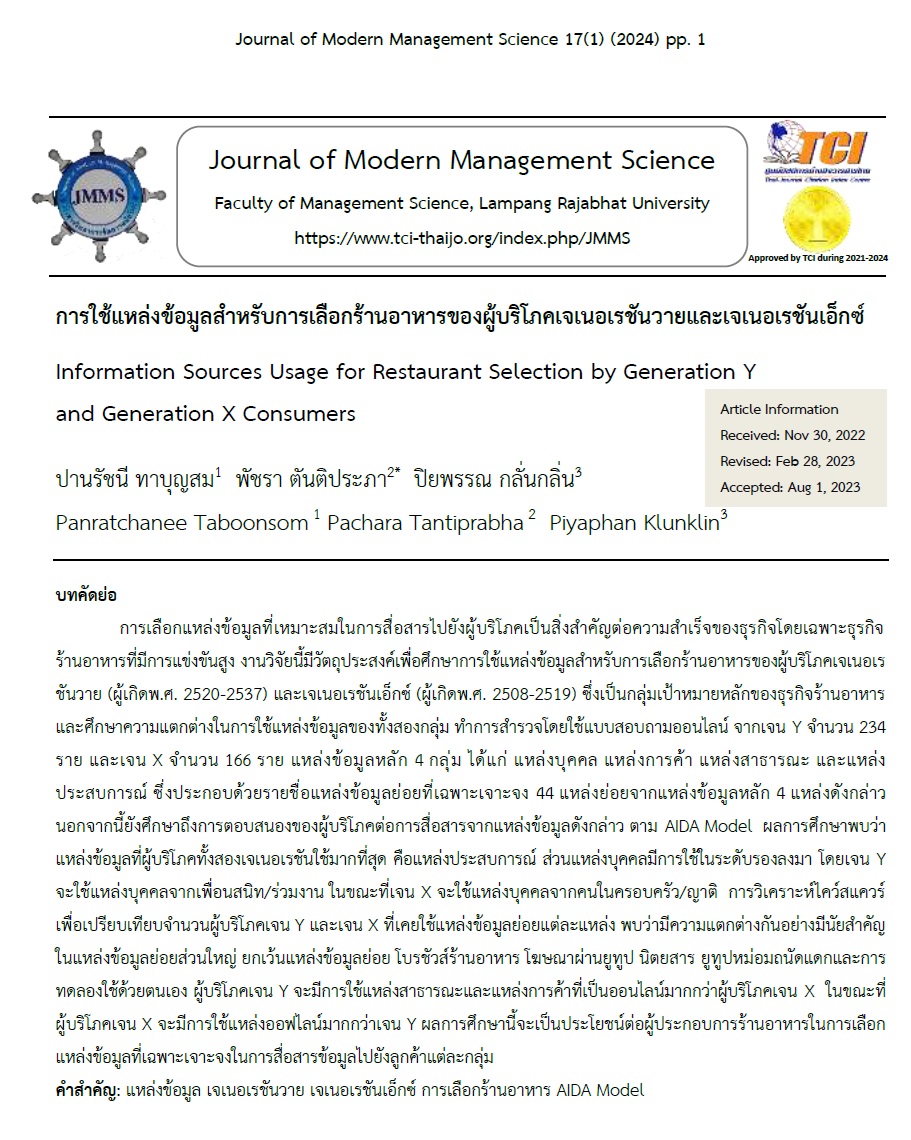Information Sources Usage for Restaurant Selection by Generation Y and Generation X Consumers
Main Article Content
Abstract
Choosing the right information source to communicate with consumers is crucial for business success, especially restaurant business with high competition. The purpose of this research was to study information sources usage to select restaurant by generation Y (those who were born between 1977-1994) and generation X (those who were born between 1965-1976) consumers and to compare the difference in information source usage of both groups. An online questionnaire survey was conduct with 234 gen Y and 166 gen X. The study main information sources consisted of personal source, commercial source, public source, and experiential source, including a list of 44 specific sub-information sources of the 4 main sources. In addition, this research also studied how consumers respond to information given in these sources by using AIDA models. The study reveals that experiential source (self-trials) is the source both generations use the most, followed by the personal source. Gen Y tend to use personal source from close friends/ colleagues, while gen X use personal source from family members/ relatives. Chi-square analyses to compare numbers of gen Y and of gen X consumers who used each sub-information source indicate significant difference of gen Y and gen X users in most of the sub-information sources, excluding restaurant brochures, YouTube ads, magazines YouTube Momtanutdag, and self-trial. Gen Y consumers use online public and commercial information sources more than gen X consumers do, while gen X consumers use offline information sources more than gen Y consumers do. Restaurant owners will get benefit from results of this study in choosing the relevant specific information sources to communicate with each target group.
Article Details

This work is licensed under a Creative Commons Attribution-NonCommercial-NoDerivatives 4.0 International License.
The article must be considered and accepted for publication by the editorial board of the Faculty of Management Science, Lampang Rajabhat University. The articles have been reviewed by a peer (peer review) and the author must update according to the suggestion if available before publication. Articles that are not considered the editorial team will inform the results of the consideration but will not send the original to the author.
JMMS is the Faculty of Management Science journal, Lampang Rajabhat University. Jmms published both print and online editions. We allow the use of articles for academic use under the scope of copyright law.
References
กุณฑรีย์ รื่นรมย์ (2560). การวิจัยตลาด. กรุงเทพฯ: สำนักพิมพ์จุฬาลงกรณ์
ดารา ทีปะปาล (2553). การสื่อสารการตลาด. กรุงเทพฯ: อมรการพิมพ์.
นธกฤต วันต๊ะเมล์ (2555). การสื่อสารการตลาด. กรุงเทพฯ: สำนักพิมพ์มหาวิทยาลัยเกษตรศาสตร์.
เสมอ นิ่มเงิน. (2560). กรมประชาสัมพันธ์. สืบค้นจาก http://www.prd.go.th/download/article/ article_201809041123 36.pdf.
สำนักบริหารการทะเบียน กรมการปกครอง กระทรวงมหาดไทย. (2562). สถิติทางการทะเบียน. สืบค้นจาก https://stat.dopa. go.th/.
สำนักงานพัฒนาธุรกรรมทางอิเล็กทรอนิกส์. (2563). ETDA เผย คน Gen -Y สั่งอาหารออนไลน์มากสุด และกว่า 40% สั่งเพราะหวั่นโควิด-19. สืบค้นจาก https://www.etda.or.th/ content /online-food-delivery-survey-during-the-preven tion-of-covid-19.html.
Abdelkader, O., A. & Rabie, M. H. (2019). Exploring the General Awareness of Young Users According to AIDA Model Applied to Social Networking Ads. Journal of Theoretical and Applied Information Technology, 97(6), 1693-1703.
Brand Buffet (2565). 4 วิธีเอาตัวรอดใน ‘ธุรกิจร้านอาหาร’ ปี 2565 แนวโน้มกลับมาโต แต่ยังเสี่ยงจาก Omicron-ต้นทุนวัตถุดิบ. 26 January 2022. สืบค้นจาก https://www.brandbuffet.in.th/2022/01/kreserch-restaurant-business-trends-2022/.
Bilgihan, A., Peng, C., and Kandampully, J. (2014). Generation Y’s Dining Information Seeking and Sharing Behavior on Social Networking Sites: An Exploratory Study. International Journal of Contemporary Hospitality Management, 26(3), 349-366.
Chaney, D. Touzani, M. & Slimane, K. B. (2017). Marketing to the (New) Generations: Summary and Perspectives. Journal of Strategic Marketing, 25(3), 179-189.
Dabija, D-C., Bejan, B. M., & Tipi, N. (2018). Generation X versus Millennials Communication Behavior on Social Media When Purchasing Food Versus Tourist Services. E+M Ekonomie a Management, 21(1), 191-205.
Euromonitor. (2022). Restaurants. Retrieved from https://www.portal.euromonitor.com/portal/statisticsevo lution/index.
Kasmo, A. B. P., Wahid, N. A., & Ismail, I. (2016). Restaurant Choice Behavior for Indonesian Gen Y, Gen X and Baby Boomers. 2nd International Conference on Advanced Research in Business and Social Sciences, 7th to 8th September, 131-141.
Kotler, P., Kartajay H., Setiawan, I. (2017). Marketing 4.0: Moving from Traditional to Digital. New Jersey: John Wiley & Sons, Inc.
Kotler, P., Kartajaya H., Setiawan, I. (2021). Marketing 5.0: Technology for Humanity. New Jersey: John Wiley & Son, Inc..
Kotler, P., Keller, K. L., & Chernev, A. (2022). Marketing Management (16th ed). United Kingdom: Pearson Education Limited.
Kotler, P., Keller, K. L., Swee, H. A., & Chiew, M. L. (2018). Marketing Management: An Asian Perspective (7th ed). United Kingdom: Prentice Hall.
Lissitsa, S. & Kol, O. (2016). Generation X vs. Generation Y – A decade of online shopping. Journal of Retailing and Consumer Services, 31, 304-312.
Liu, S-F., Li, Z-X., & Zhang, Y. (2023). Sustainable Operation of Fine-Dinning Restaurants: Antecedents and Consequences of Customers’ Self-Image Congruity at a Cantonese Michelin-Starred Restaurant Based on the Value-Attitude-Behavior Model. Sustainability, 15, 1-21.
Marketeer (2565). ธุรกิจร้านอาหารปี 2565 ยังโตได้อีกท่ามกลางพฤติกรรมการบริโภคและกำลังซื้อที่เปลี่ยนไป. สืบค้นจาก https://marketeeronline.co/archives/264048.
Min, J, Kim, J.& Yang, K. (2016). How Generations Differ in Coping with a Pandemic: The Case of Restaurant Industry. Journal of Hospitality and Tourism Management, 48, 280-288.
Mothersbaugh, D. L., Hawkins, L. D., & Kleiser, S. B. (2020). Consumer Behavior: Building Marketing Strategy (14th ed). New York, USA: McGraw-Hill.
Reisenwitz, T. H. & Iyer, R. (2009). Differences in Generation X and Generation Y: Implications for the Organization and Marketers. The Marketing Management Journal, 19(2), 91-103.
Schiffman, L.G. & Wisenblit, J. (2019). Consumer Behavior (14th ed). Harlow, United Kingdom: Pearson Education Limited.
Wahyuningsih, Nasution, H., Yeni, Y. H. & Roostika, R. (2022). How Generations Differ in Coping with a Pandemic: The Case of Restaurant Industry. Cogent Business & Management, 9, 1-20.


